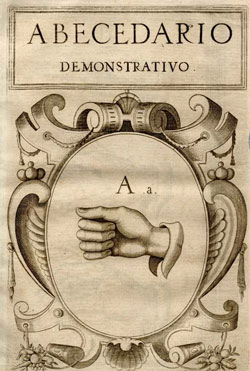Fingerspelling History
The manual alphabet used in ASL consists of 26 individual hand shapes corresponding to letters of the English alphabet and has its historical roots in Spain.
The hand shapes of the manual alphabet were originally taken from a book of prayers written by a Franciscan monk, Melchor Yebra in 1593. Each letter of the alphabet had a prayer associated with it; if a monk was too ill to recite the prayer, he could indicate his prayer intent by making the corresponding hand shape (Lane, 1984). Use of the hand shapes to form whole words and messages evolved, allowing monks to communicate without violating their vows of silence (Schein, 1984).


PLEASE NOTE: THESE ARE HISTORICAL GRAPHICS. YOU SHOULD ALWAYS FINGERSPELL WITH YOUR LETTERS / PALM FACING FORWARD.
On the left: Lengua de Signos by Juan Pablo Bonet in 1620. The manual alphabet was included in this first book on deaf education. In the Public Domain CC PD-Old.
On the right: Public document from the legislature of Connecticut in 1882. In the Public Domain CC PD-Old.
The concept of a hand shape to represent letters of the alphabet was then borrowed for use in educating the deaf at the National Institution for Deaf-Mutes in Paris, where Laurent Clerc was a pupil and an instructor. In 1817, when he and Thomas Gallaudet established the American Asylum for the Education and Instruction of Deaf and Dumb Persons in Hartford, Connecticut, fingerspelling was an integral component of signed language.
In the 1950s and 60s, the Rochester Method of educating deaf students required both teachers and students to speak English and fingerspell each word simultaneously. Everything from daily lessons to the school play was done this way.
While fingerspelling in other countries is not used in all sign languages to the same extent it is used in ASL, most national sign languages have developed some kind of fingerspelled alphabet. One-handed or two-handed, most of these alphabets correspond to those of the spoken or written languages used in those countries.
Fingerspelling, as used in the United States, is a direct, letter-by-letter representation of English words. As an incorporated component of sign language communication, fingerspelling has various but specific uses within ASL.

Signing Savvy Member Feature: Download this image / flyer as a printable PDF page.
Resources
Adapted from: Cartwright, B. E., & Bahleda, S. J. (2007). Fingerspelling History. In Fingerspelling in American Sign Language (2nd ed., p. viii). RID Press.
- Lane, H. (1984). When the mind hears: A history of the Deaf. New York: Random House.
- Schein J. D. (1984). Speaking the Language of Sign: The Art and Science of Signing. Doubleday Books.
ADVERTISEMENTS
 Brenda Cartwright is a Coda, seasoned interpreter, a master teacher, well known presenter, and author of several best selling sign language and interpreting textbooks from the RID Press. For 35 years Brenda was the Chair of the Sign Language Interpreter Program at Lansing Community College in Lansing, Michigan.
Brenda Cartwright is a Coda, seasoned interpreter, a master teacher, well known presenter, and author of several best selling sign language and interpreting textbooks from the RID Press. For 35 years Brenda was the Chair of the Sign Language Interpreter Program at Lansing Community College in Lansing, Michigan. Tips When Starting to Fingerspell
Tips When Starting to Fingerspell Signing Space When Fingerspelling
Signing Space When Fingerspelling Fingerspelling Warm-Up Activities to Prevent Repetitive Motion Injuries
Fingerspelling Warm-Up Activities to Prevent Repetitive Motion Injuries







